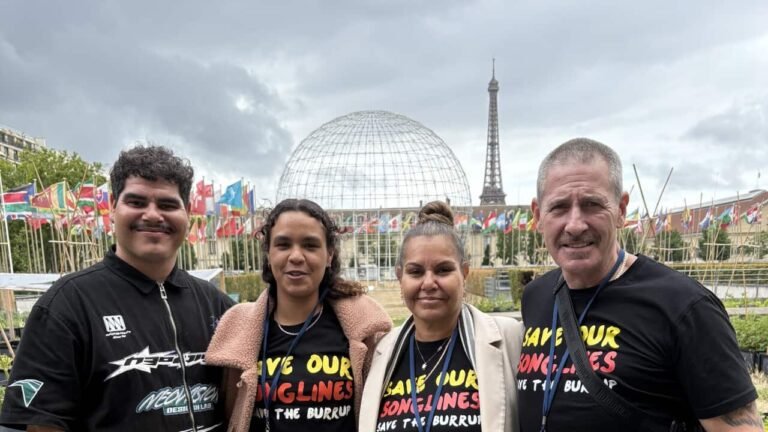Industrial pollution is highly likely to be damaging ancient Aboriginal rock art that has been nominated as a World Heritage site, research shows.
Murujuga, on the Burrup peninsula in Western Australia, contains the world’s largest, densest and most diverse collection of rock art engravings, known as petroglyphs, and some are estimated to be more than 50,000 years old.
A UNESCO meeting in Paris is due to decide what happens with the World Heritage nomination this week, with delegations from the Murujuga Aboriginal Corporation (MAC) and the Australian Government, led by Environment Minister Murray Watt, both travelling to France to attend.
Mardathoonera woman Raelene Cooper, a Murujuga traditional custodian and former chair of the Murujuga Aboriginal Corporation, is also in Paris as an observer and says she is deeply concerned about an amendment removing protective recommendations that is being pushed by the Australian government.
In May the independent body that advises UNESCO on World Heritage listings, ICOMOS, referred the nomination back to Australia, citing concerns about degrading acidic emissions, caused by nearby industry, and saying they should be stopped.
The peninsula in northwest WA near Karratha is home to two gas plants, a fertiliser plant and iron ore and salt export facilities.
The industrial emissions they produce cause lower pH and higher acid levels in the local rainwater and on the rock surfaces, a study by Bonn University in Germany has found.
But Ms Cooper says she has grave concerns about an Australian amendment to the nomination, which revokes the requirement for decommissioning and rehabilitation of existing harmful industry impacting the site; removes the recommendation regarding no further expansion of industry, and replaces it with a recommendation that enables further industrial expansion and deletes the requirement for removal of harmful acid gas emissions.
On the same day ICOMOS published its recommendations, Senator Watt issued approval to Woodside for extending its North West Shelf project until 2070, including the Karratha gas plant, adjacent to Murujuga.
“UNESCO’s draft decision included a number of essential protections for Murujuga, based on sound recommendations from the independent expert advisory body ICOMOS,” Ms Cooper said.
“We are deeply concerned that the amendment being pushed by the Australian government will dramatically weaken these critical recommendations.
“If the government gets its way, the changes would pave the way for further industrial development.”
Before leaving for Paris MAC, which represents the collective voice of Ngarda-Ngarli (Traditional Owners and Custodians for Murujuga), chair Peter Hicks said they were hopeful of receiving immediate inscription, which would mean the highest level of heritage protection and management available under Australian law.
Murujuga Aboriginal Corporation (MAC) chair Peter Hicks and board member Belinda Churnside (Ngarluma) at Karratha Airport, heading to Paris.
“This is a long-awaited and immensely significant moment,” Mr Hicks said about the UNESCO decision.
“This extraordinary landscape has been managed and cared for by our ancestors for more than 50,000 years and is a sacred, spiritual and deeply storied place.
“Its importance to the world cannot be understated with one of the most extensive and ancient collections of petroglyphs in the world and it provides a visual record of how our ancestors have lived, practised their culture and interacted with this landscape over thousands of generations.”
Members of MAC are subject to the Burrup and Maitland Industrial Estates Agreement (BMIEA), signed by representatives of the Ngarluma-Yindjibarndi, Wong-Goo-Tt-Oo, and Yaburara Mardudhunera peoples in 2003.
A clause in the BMIEA says Traditional Owners of the Burrup will not lodge or cause to be lodged any objection to development proposals intended to occur on land within the industrial estate.
The Bonn University study used an accelerated weathering experiment simulating six years of exposure to rainwater with various acidity levels and found industrial emissions were already likely to be degrading the outer layer of the rocks where the petroglyphs are etched.
“The rock varnish on petroglyph-bearing rocks from Murujuga is highly likely impacted by local industrial pollution, with weathering rates most likely already accelerated due to the lower pH of the rainwater,” the study said.
A pH level of less than 7 is acidic, with lower numbers meaning a higher level of acid.
The study found it is highly probable that weathering rates will increase further if the pH continues to decrease and that the dissolution of the rock surface increased significantly at pH less than 5.
Previous reports show acid rain with a pH below 5.6 frequently occurs on Murujuga, with an average pH of 4.6, and that the environment has become more acidic over time, the study said.
“It is essential that the final UNESCO decision requires a moratorium on any extensions or expansions of industry located on Murujuga,” Ms Cooper said.
“It needs to have a decommissioning and rehabilitation plan, and to strengthen the management of Murujuga by traditional custodians by guaranteeing resources so industry funding is not relied upon.
“We also need to reform the foundation agreements between the government and traditional custodians to remove ‘no objection’ clauses, establish consultation requirements, and ensure free, prior and informed consent in relation to all decisions affecting Murujuga.”
Murujuga and the surrounding islands are believed to contain more than a million petroglyphs.
They depict animals – some of which are now extinct – plants and human figures, and are visible due to the colour and contrast between the removed varnish layer and the underlying brighter weathered rind of the host rocks.





